Page 72 of 388
Downloaded from www.Manualslib.com manuals search engine Engine Coolant Heater (Option)
In very cold weather, 0°F (- 18 O C) or colder, the engine
coolant heater can help. You’ll get easier starting and
better fuel economy during engine warm-up. Usually,
the coolant heater should be plugged in a minimum
of
four hours prior to starting your vehicle.
To use the coolant heater:
1. Turn off the engine.
2. Open the hood and unwrap the electrical cord.
3. Plug it into a normal, grounded 1 10-volt outlet.
2-20
Page 73 of 388
Downloaded from www.Manualslib.com manuals search engine NOTICE:
After you’ve used the coolant heater, be sure to store the cord as it was before to keep it away
from moving engine parts.
If you don’t, it could
be damaged.
Automatic Transmission
How long should you keep the coolant heater plugged
in? The answer depends on the weather, the kind of oil
you have, and some other things. Instead of trying to list
everything here, we ask that you contact your Chevrolet
dealer in the area where you’ll be parking your vehicle.
The dealer can give you the best advice for that
particular area.
There
are several different positions for your shift lever.
2-21
Page 139 of 388
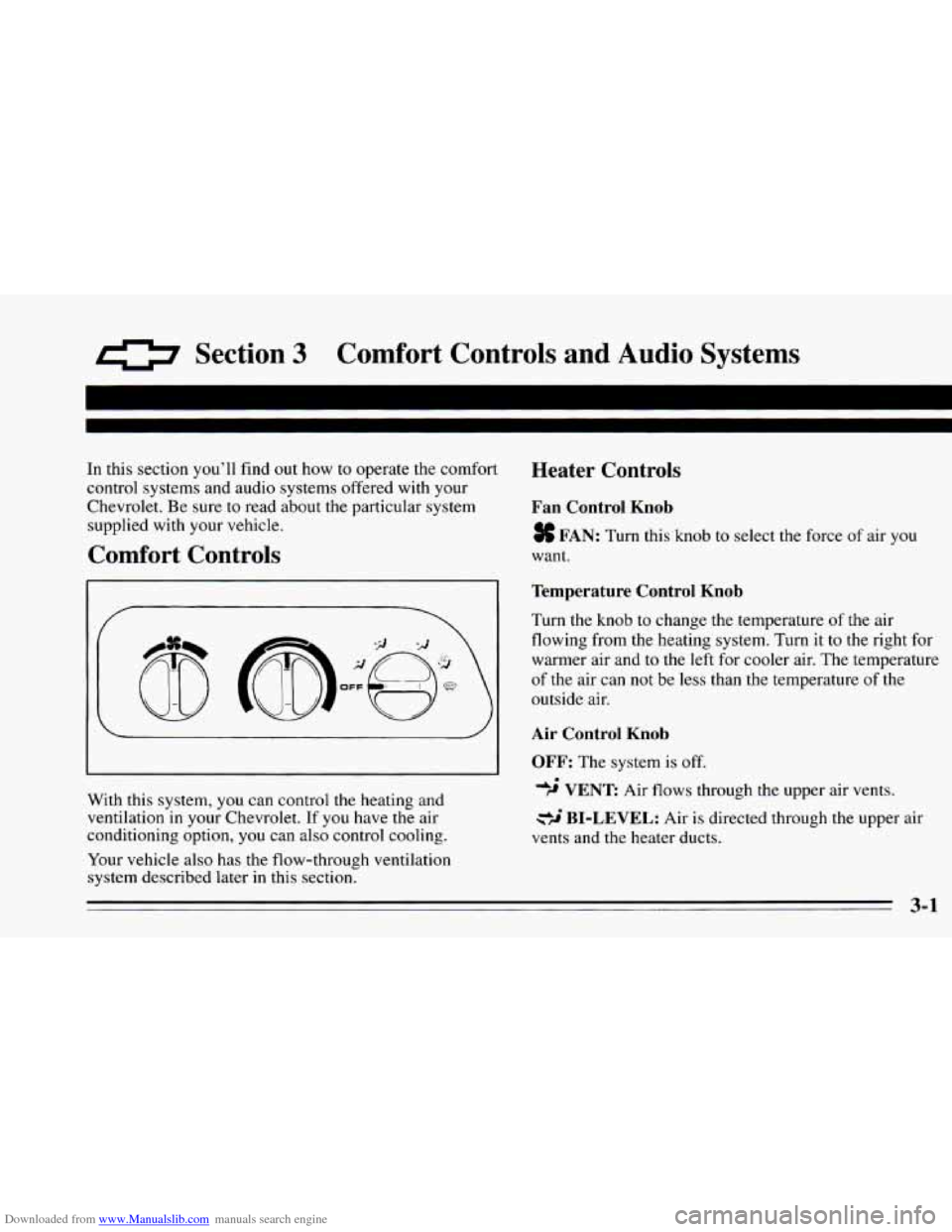
Downloaded from www.Manualslib.com manuals search engine 0 Section 3 Comfort Controls and Audio Systems
In this section you'll find out how to operate the comfort
control systems and audio systems offered with your
Chevrolet. Be sure to read about the particular system
supplied with your vehicle.
Comfort Controls
Heater Controls
Fan Control Knob
$$ FAN: Turn this knob to select the force of air you
want.
With this system,
you can control the heating and
ventilation
in your Chevrolet. If you have the air
conditioning option, you can also control cooling.
Your vehicle also has the flow-through ventilation
system described later
in this section.
Temperature Control Knob
Turn the knob to change the temperature of the air
flowing from the heating system. Turn it
to the right for
warmer air and to the left for cooler air. The temperature
of the air can not be less than the temperature of the
outside air.
Air Control Knob
OFF:
The system is off.
4' # VENT: Air flows through the upper air vents.
BI-LEVEL: Air is directed through the upper air
vents and the heater ducts.
3-1
Page 140 of 388
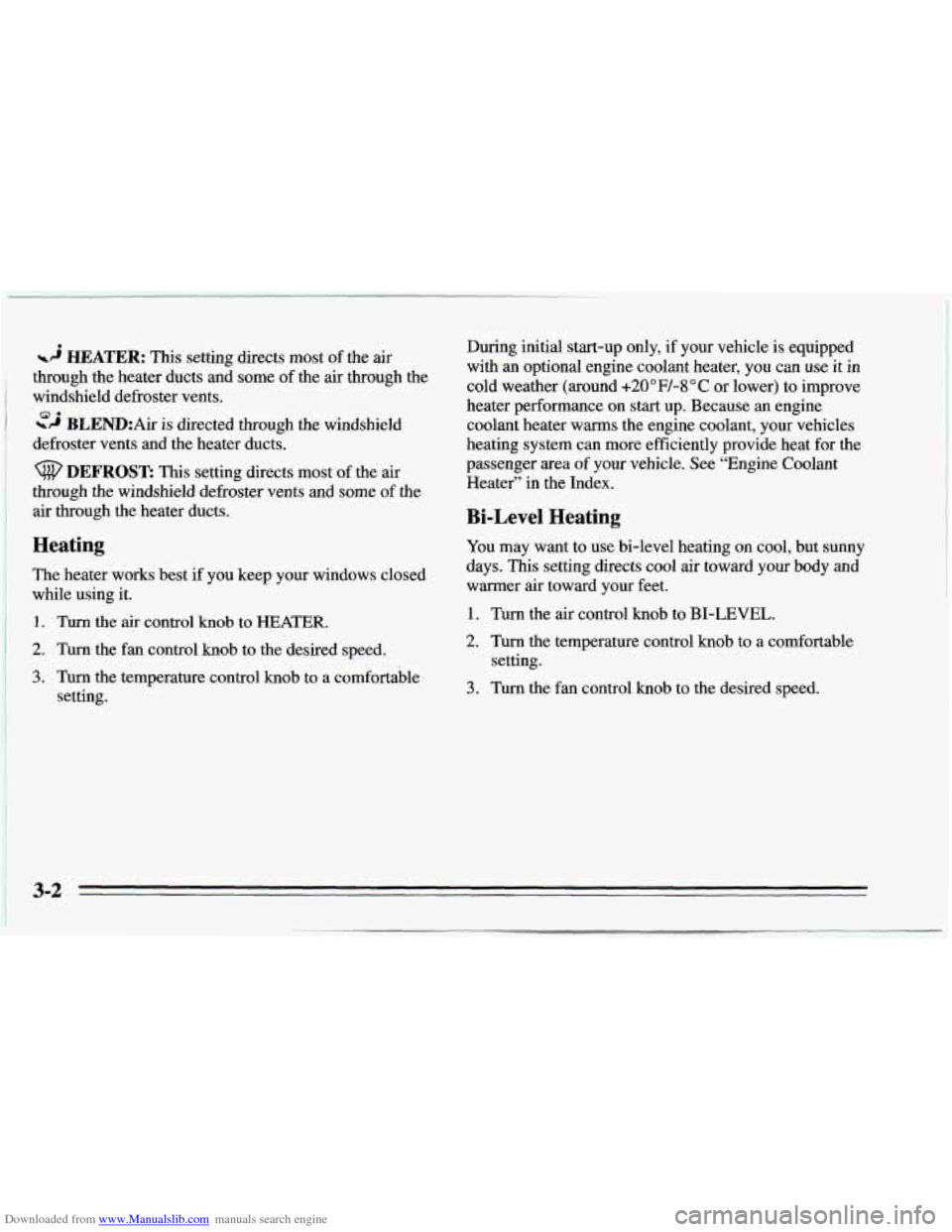
Downloaded from www.Manualslib.com manuals search engine -3 HEATER: This setting directs most of the air
through the heater ducts and some of
the air through the
windshield defroster vents.
zi BLEND:Air is directed through the windshield I I defroster vents and the heater ducts.
I DEFROST: This setting directs most of the air
j through the windshield defroster vents and some of the
air through the heater ducts.
I Heating
I The heater works best if you keep your windows closed
while using it.
, 1. Turn the air control knob to HEATER.
2. Turn the fan control knob to the desired speed.
~ 3. Turn the temperature control knob to a comfortable
setting. During
initial start-up only, if your vehicle
is equipped
with an optional engine coolant heater,
you can use it in
cold weather (around
+20°F/-8”C or lower) to improve
heater performance
on start up. Because an engine
coolant heater warms the engine coolant, your vehicles
heating system can more efficiently provide heat for the
passenger area of your vehicle. See “Engine Coolant
Heater” in the Index.
Bi-Level Heating
You may want to use bi-level heating on cool, but sunny
days. This setting directs cool air toward your body and
warmer air toward your feet.
1. Turn the air control knob to BI-LEVEL.
2. Turn the temperature control knob to a comfortable
3. Turn the fan control knob to the desired speed.
setting.
3-2
Page 141 of 388
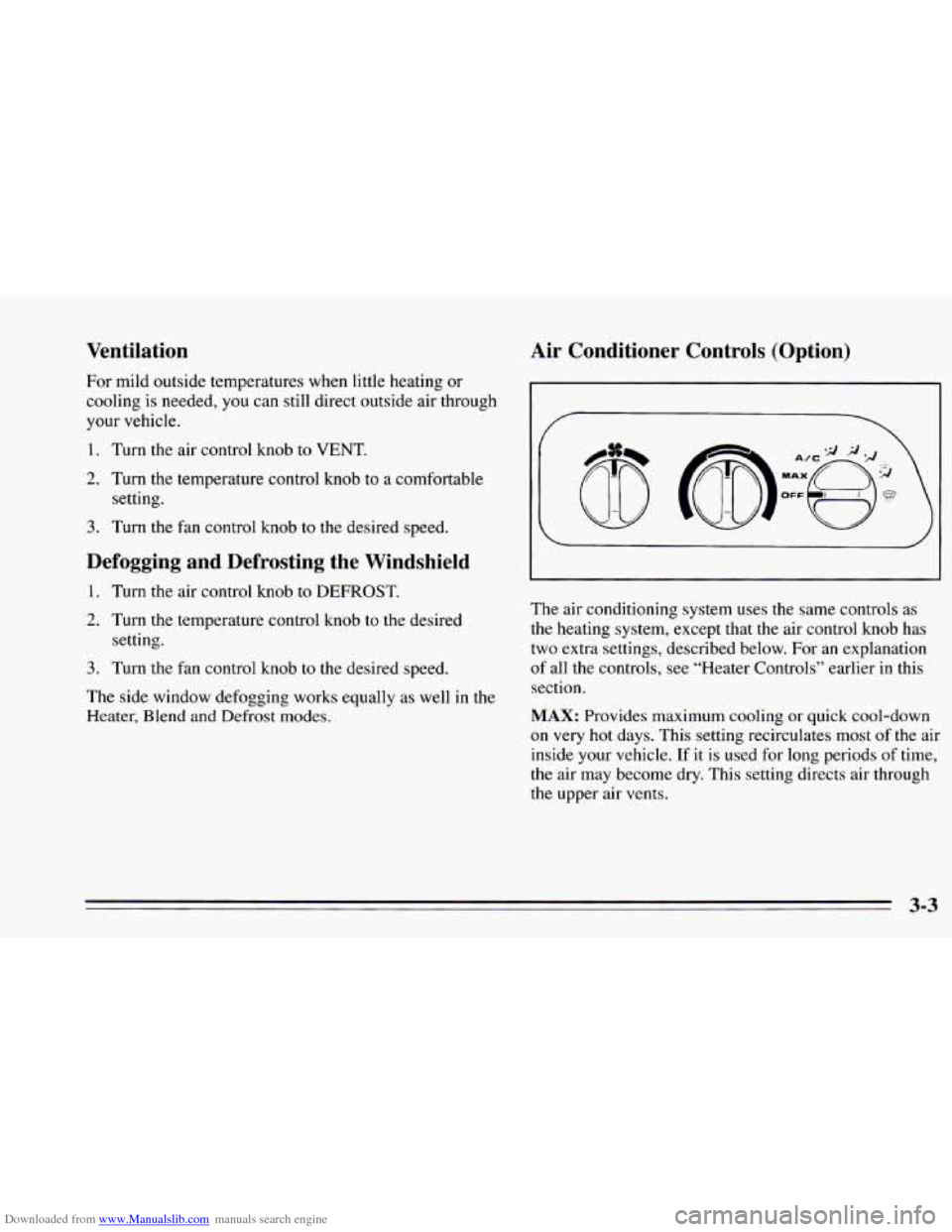
Downloaded from www.Manualslib.com manuals search engine Ventilation
For mild outside temperatures when little heating or
cooling is needed, you can still direct outside air through
your vehicle.
1. Turn the air control knob to VENT.
2. Turn the temperature control knob to a comfortable
3. Turn the fan control knob to the desired speed.
Defogging and Defrosting the Windshield
1. Turn the air control knob to DEFROST.
2. Turn the temperature control knob to the desired
setting.
setting.
3. Turn
the fan control knob to the desired speed.
The side window defogging works equally as well
in the
Heater, Blend and Defrost modes.
Air Conditioner Controls (Option)
The air conditioning system uses the same controls as
the heating system, except that the air control knob has
two extra settings, described below. For an explanation
of all the controls, see “Heater Controls’’ earlier in this
section.
MAX: Provides maximum cooling or quick cool-down
on very hot days.
This setting recirculates most of the air
inside your vehicle. If it is used for long periods of time,
the air may become dry. This setting directs air through
the upper air vents.
3-3
Page 143 of 388
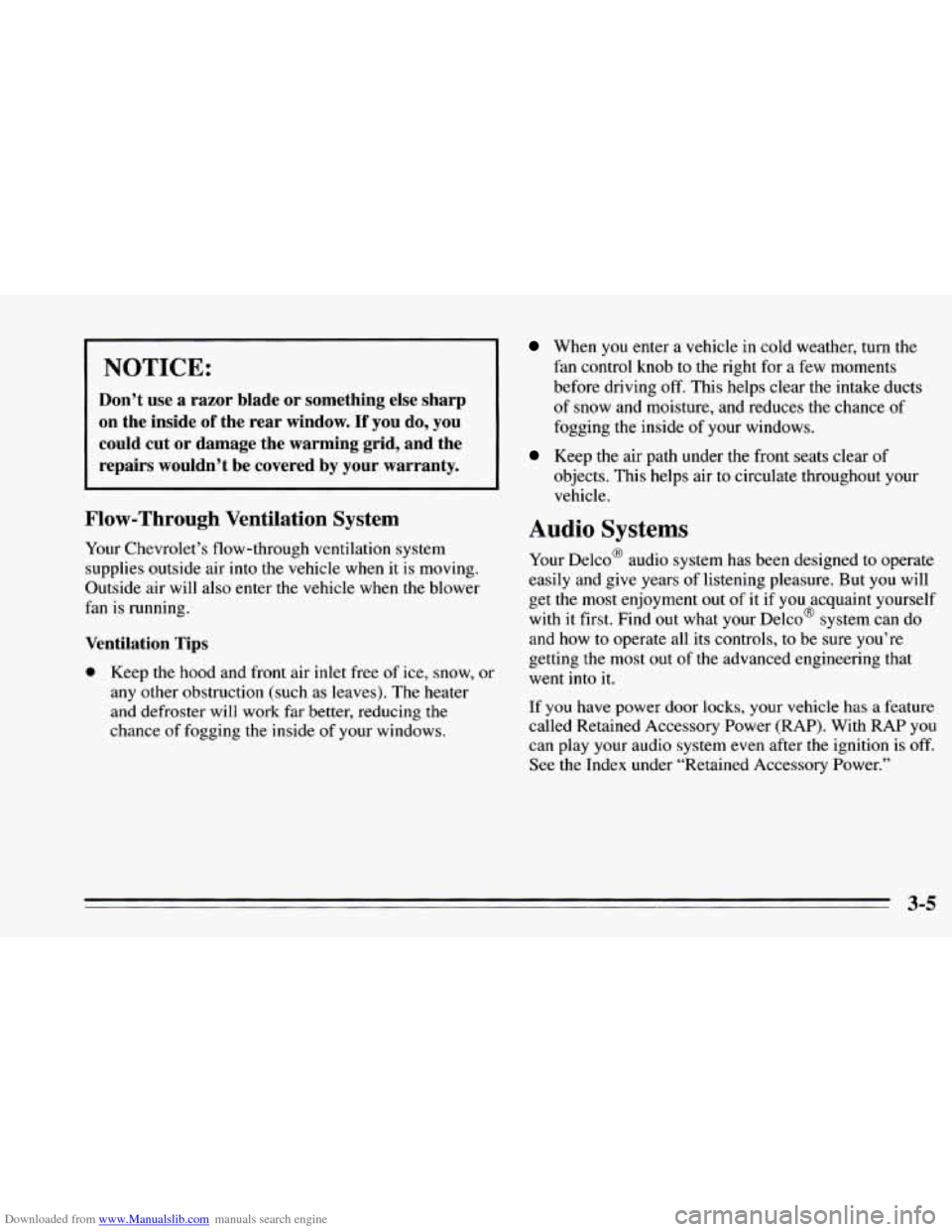
Downloaded from www.Manualslib.com manuals search engine I NOTICE:
Don’t use a razor blade or something else sharp
on the inside
of the rear window. If you do, you
could cut or damage the warming grid, and the
repairs wouldn’t be covered by your warranty.
Flow-Through Ventilation System
Your Chevrolet’s flow-through ventilation system
supplies outside air into the vehicle when it is moving.
Outside air will also enter the vehicle when the blower
fan is running.
When you enter a vehicle in cold weather, turn the
fan control knob
to the right for a few moments
before driving
off. This helps clear the intake ducts
of snow and moisture, and reduces the chance
of
fogging the inside of your windows.
objects. This helps air to circulate throughout your
vehicle.
Keep the air path under the front seats clear of
Audio Systems
Your Delco@ audio system has been designed to operate
easily and give years of listening pleasure. But you will
get the most enjoyment out of
it if you acquaint yourself
with
it first. Find out what your DelcoB system can do
Ventilation Tips and how to operate all its controls, to be sure you’re
0 Keep the hood and front air inlet free of ice, snow, or went into it.
getting the most out of the advanced engineering that
any other obstruction (such
as leaves). The heater
and defroster will work far better, reducing the If you have power door locks,
your vehicle has a feature
chance of fogging the inside of your windows. called Retained Accessory Power (RAP). With RAP you
can play your audio system even after the ignition is off.
See the Index under “Retained Accessory Power.”
Page 184 of 388
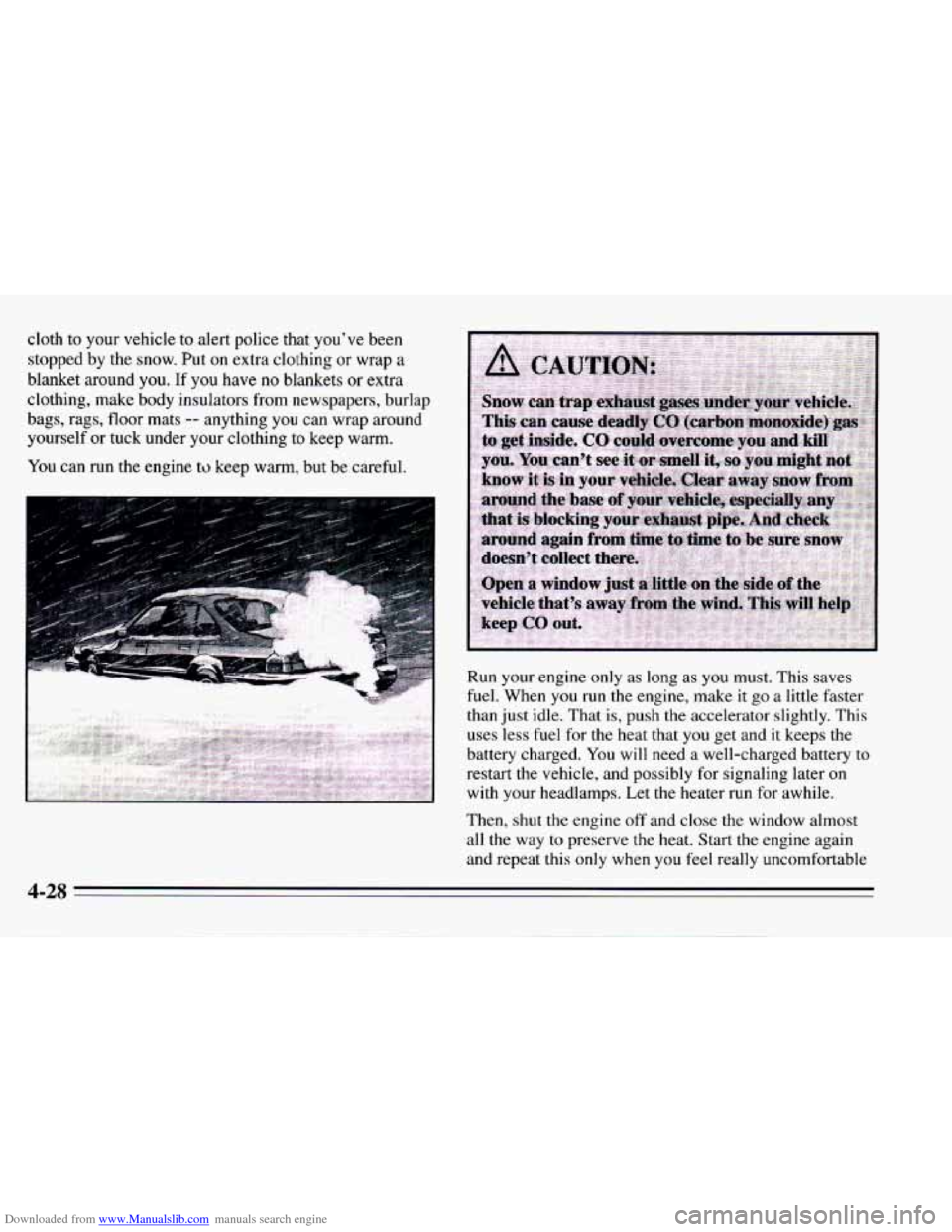
Downloaded from www.Manualslib.com manuals search engine cloth to your vehicle to alert police that you’ve been
stopped by the snow. Put
on extra clothing or wrap a
blanket around you. If you have no blankets or extra
clothing,
make body insulators from newspapers, burlap
bags, rags, floor mats
-- anything you can wrap around
yourself
or tuck under your clothing to keep warm.
You can
run the engine to keep warm, but be careful.
Run your engine only as long as you must. This saves
fuel. When you run the engine, make it
go a little faster
than just idle. That
is, push the accelerator slightly. This
uses less fuel for the heat that you get and it keeps the
battery charged. You
will need a well-charged battery to
restart the vehicle, and possibly for signaling later
on
with your headlamps. Let the heater run for awhile.
Then,
shut the engine off and close the window almost
all the way to preserve the heat. Start the engine again
and repeat this only when you feel really uncomfortable
4-28
. ..
Page 208 of 388
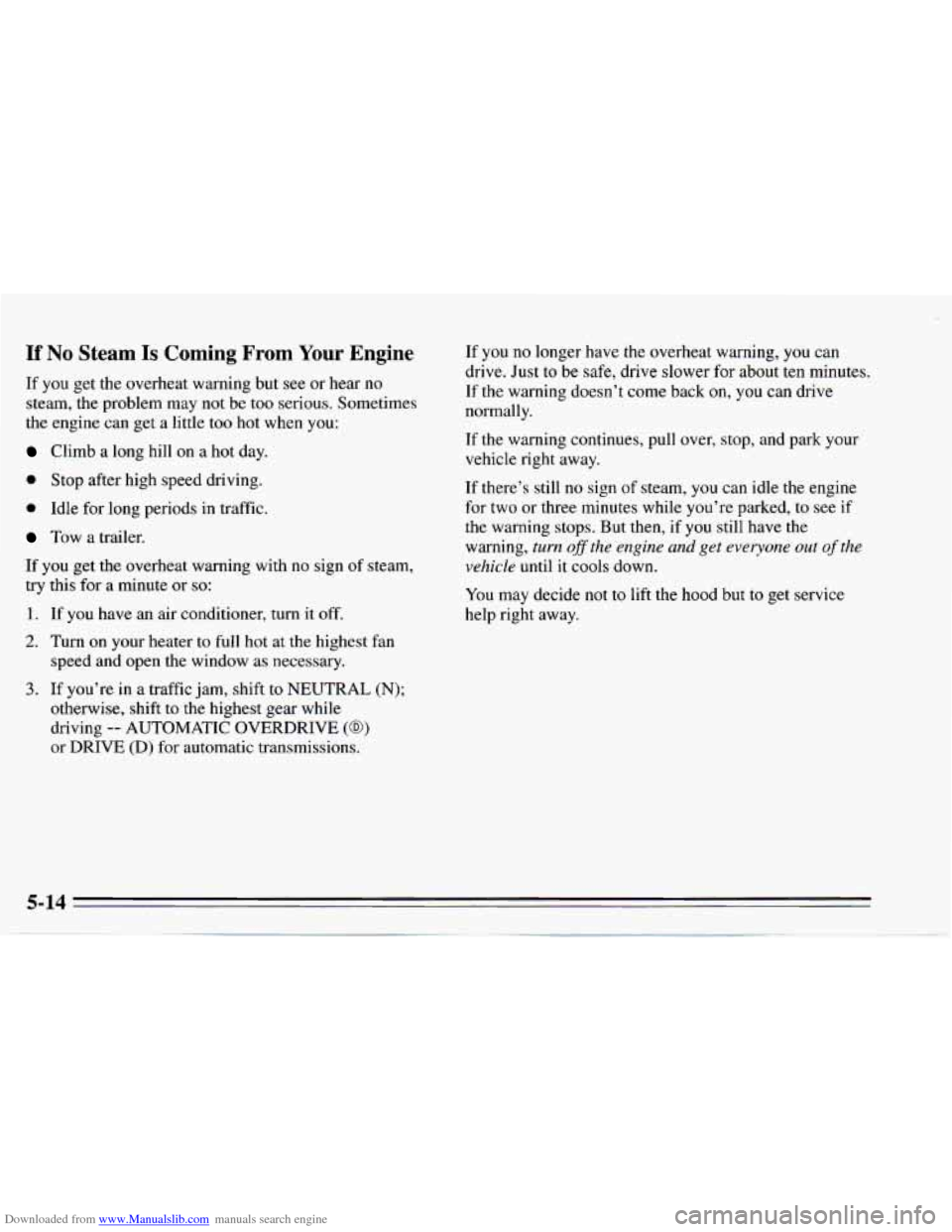
Downloaded from www.Manualslib.com manuals search engine If No Steam Is Coming From Your Engine
If you get the overheat warning but see or hear no
steam, the problem may not be
too serious. Sometimes
the engine can get a little too hot when you:
Climb a long hill on a hot day.
0 Stop after high speed driving.
0 Idle for long periods in traffic.
Tow a trailer.
If you get the overheat warning with no sign
of steam,
try this for a minute or
so:
1. If you have an air conditioner, turn it off.
2. Turn on your heater to full hot at the highest fan
speed and open the window as necessary.
3. If you’re in a traffic jam, shift to NEUTRAL (N);
otherwise, shift to the highest gear while
driving
-- AUTOMATIC OVERDRIVE (a)
or DRIVE (D) for automatic transmissions. If you
no longer
have the overheat warning, you can
drive. Just
to be safe, drive slower for about ten minutes.
If the warning doesn’t come back
on, you can drive
normally.
If the warning continues, pull over, stop, and park your
vehicle right away.
If there’s still no sign
of steam, you can idle the engine
for two or three minutes while you’re parked,
to see if
the warning stops. But then, if you still have the
warning,
turn ofSthe engine and get everyone out of the
vehicle
until it cools down.
You may decide not to lift the hood but to get service
help right away.